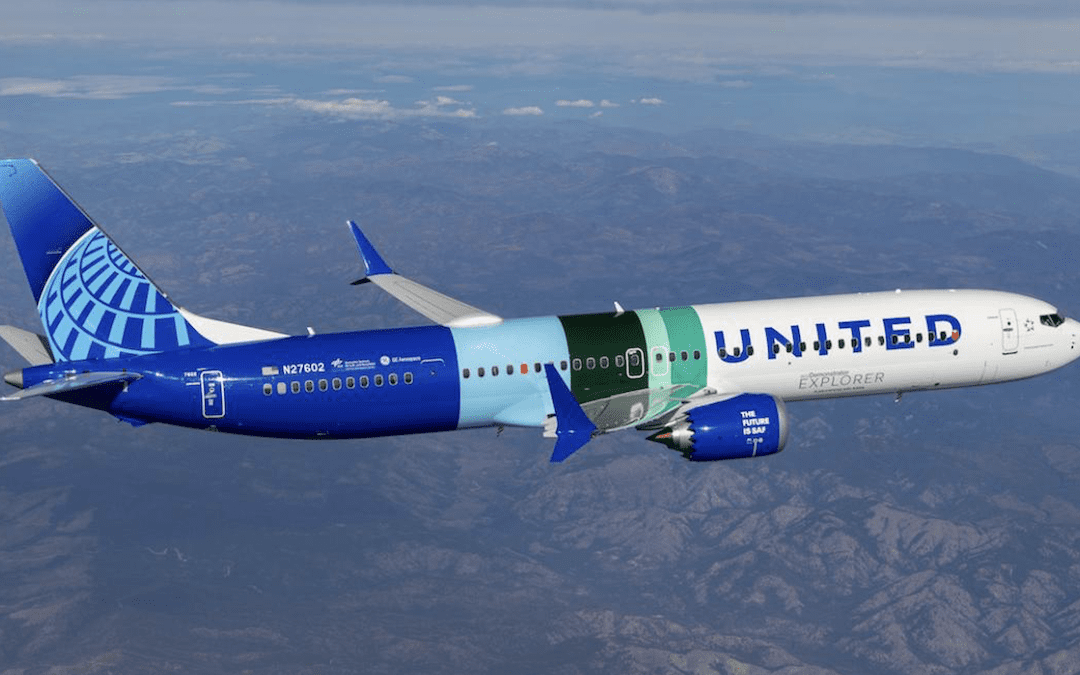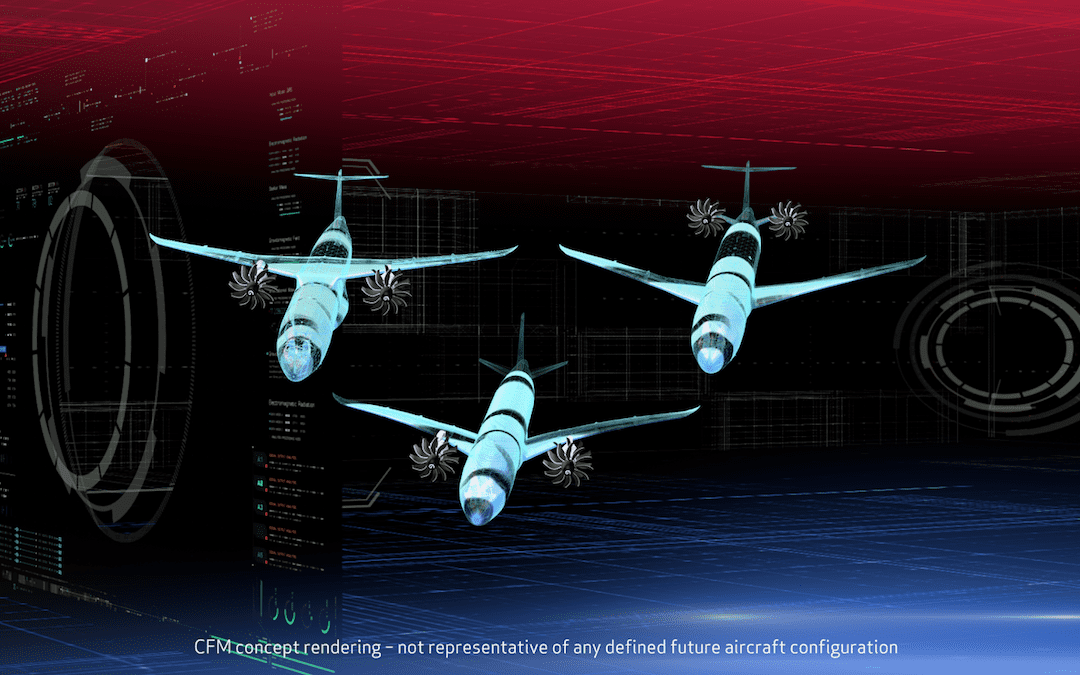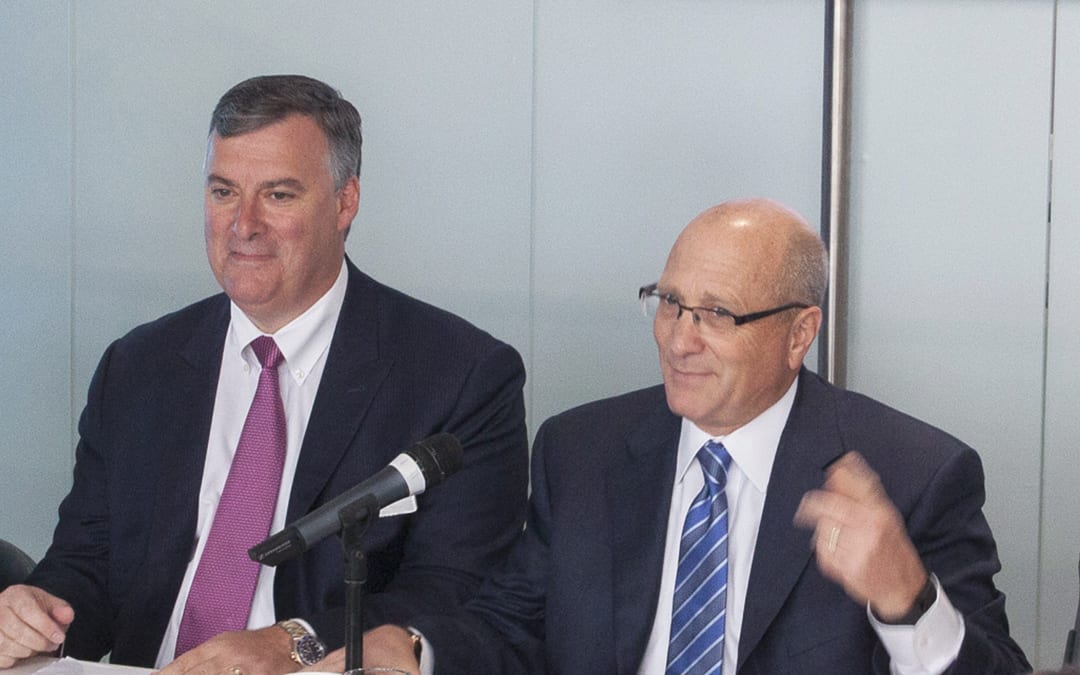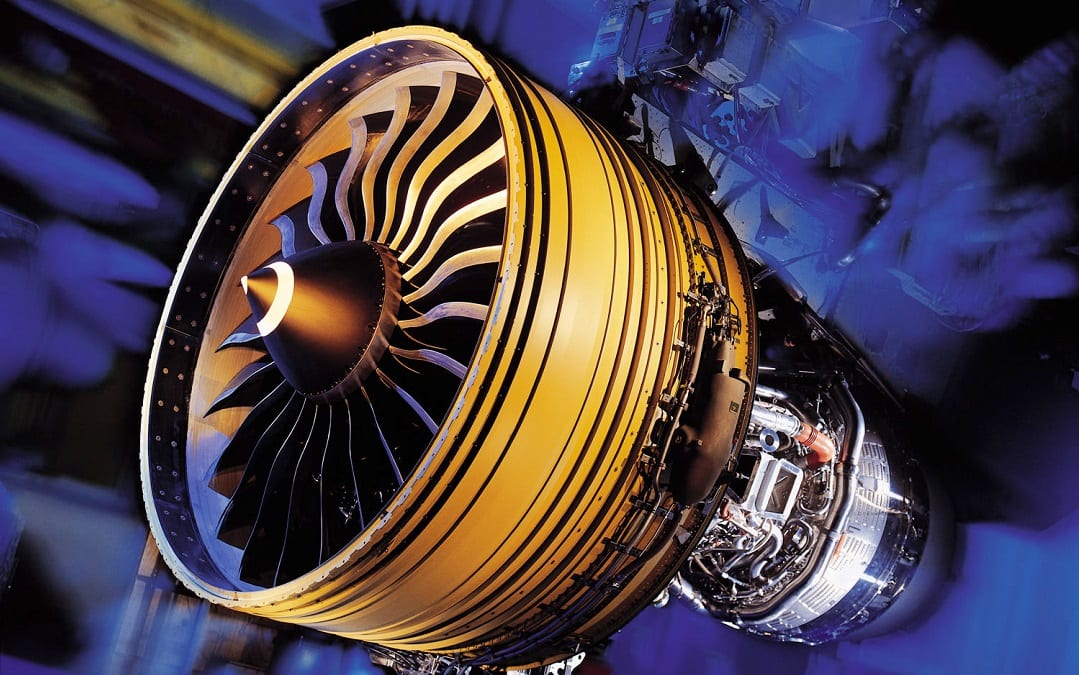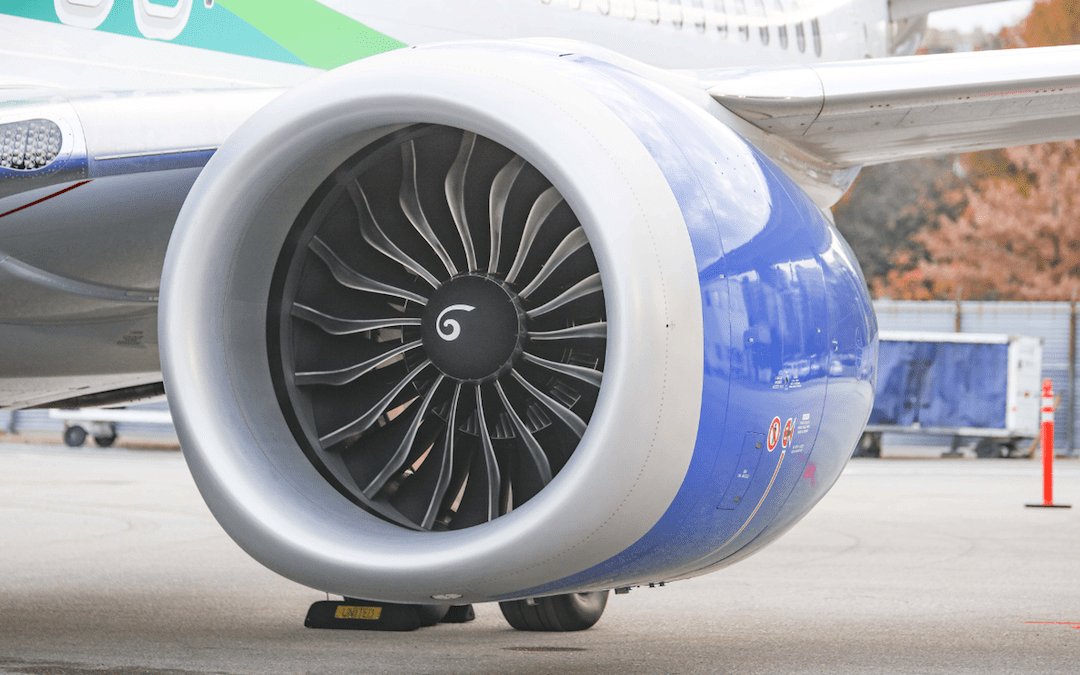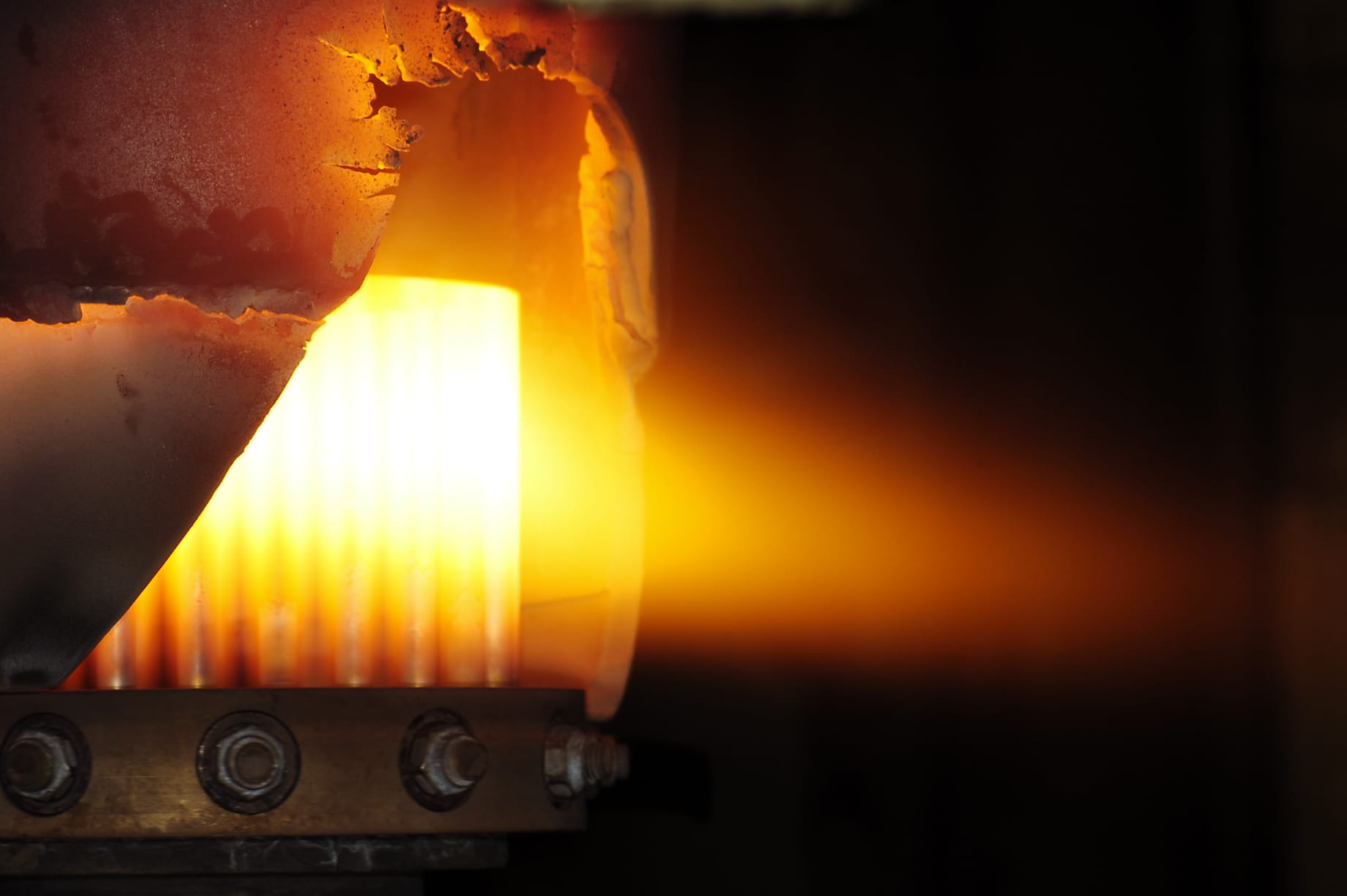Flight Path: A Look Back at GE Aerospace’s Progress to Reduce Emissions in 2023
December 08, 2023 | by GE Reports
Two years ago, the Air Transport Action Group (ATAG), of which GE Aerospace is a member, set an ambitious goal of achieving net zero carbon emissions by 2050. To gauge the progress the industry has made toward that target, GE Aerospace this summer commissioned a survey of 325 aviation decision makers in the U.S., the U.K., China, India, the UAE, and France.
Seventy-six percent of those decision makers — representing airlines, airframers, and airports, among others — said that the focus on sustainability has fundamentally changed the way the industry operates. But, they added, reaching the 2050 goal will mean stepping up the pace. Respondents also indicated that advancements in both fuels and engines will play the biggest role in making net zero a reality. These are both areas of emphasis “in which GE Aerospace has taken a leadership role,” GE Chairman and CEO and GE Aerospace CEO Larry Culp said.
As we look back on this year’s developments, here are some key examples of what Culp was describing.
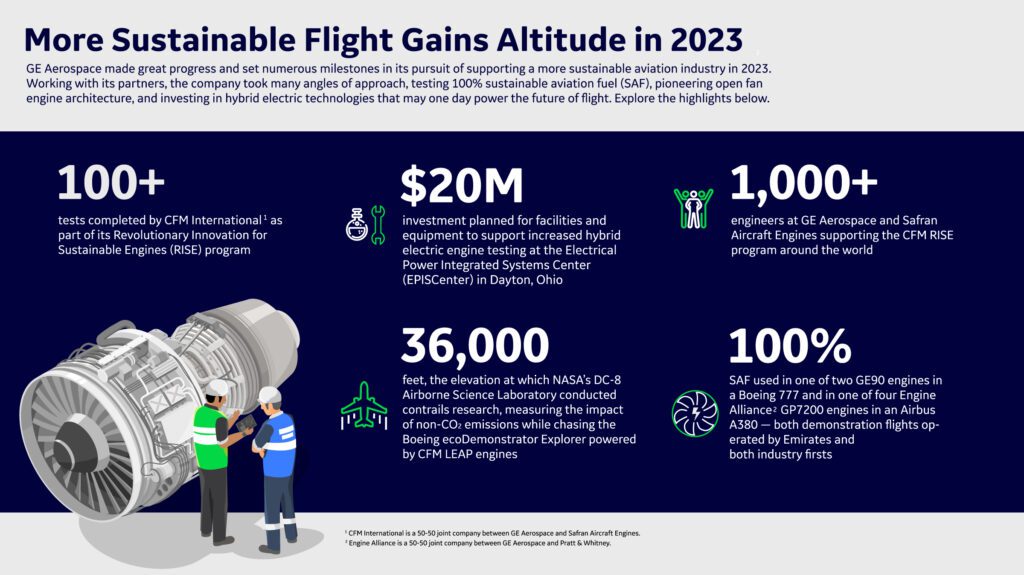
CFM’s RISE Program
In 2021, CFM International, a 50-50 joint company between GE Aerospace and Safran Aircraft Engines, announced its Revolutionary Innovation for Sustainable Engines (RISE) program to advance a suite of new technologies, such as open fan architecture, with the aim of achieving at least 20% better fuel efficiency and 20% lower CO2 emissions than the most efficient engines today.
As of mid-2023, CFM had completed more than 100 tests as part of the RISE program, and GE Aerospace and Safran Aircraft Engines together have more than 1,000 engineers globally supporting the development of RISE program technologies. CFM is on track for ground and flight tests in the middle of this decade, including plans with Airbus for an open fan flight technology demonstration in the mid-2020s.
“The RISE program was launched as the absolute manifestation of our deep dedication to push the boundaries of innovation and deliver the breakthrough technologies that will help achieve our most aggressive sustainability goals in support of the industry promise of net zero by 2050,” says Gaël Méheust, president and CEO of CFM International. “Our global team of engineers has been accomplishing amazing things.” Read more about CFM’s RISE program here.
Hybrid Electric Flight
“GE Aerospace envisions a more electric future of flight,” says Arjan Hegeman, general manager of advanced technology for GE Aerospace. NASA’s Electrified Powertrain Flight Demonstration (EPFD) project is a landmark effort to help prove the feasibility of hybrid electric flight for commercial aviation. Working with NASA and Boeing, GE Aerospace is developing an integrated, megawatt-class hybrid electric propulsion system for ground and flight tests in the middle of this decade. Hybrid electric propulsion technologies can help improve engine performance, which reduces fuel usage and carbon emissions. In July, GE Aerospace debuted a new livery design for the aircraft test bed to be used in that project, a modified Saab 340B aircraft powered by GE Aerospace CT7 engines.
“Whether we’re going to be burning Jet A, SAF, hydrogen, or if we’re going to have batteries or fuel cells,” says Joseph Connolly, aerospace engineer at NASA’s Glenn Research Center, “the electrification of the subsystems and other components within the propulsion system on these aircraft is going to be more electric in the future.”
Read more about the EPFD project.
Sustainable Aviation Fuel
“Every piece of analysis shows that SAF is the most impactful way to cut aviation’s carbon emissions before 2050,” said Air Transport Action Group Executive Director Haldane Dodd this fall. At GE Aerospace, “SAF is not just an R&D project we conduct on the side,” said Gurhan Andac, the company’s engineering technical leader for aviation fuels and additives, in October. “It’s in the field. We have over half a million flights in the aviation industry. Granted, these are at very low volumes, but it’s out there and we’re flying.”
All GE Aerospace, CFM International, and Engine Alliance engines can operate on approved SAF blends today. SAF has the same chemical composition as the jet fuel most commonly used today, but instead of being made from fossil-based sources, SAF is made from more renewable sources that include plant-based material, fats, oils and greases, alcohols, waste streams, captured CO2, and other alternative feedstocks. The use of alternative feedstocks and processes reduces life-cycle CO2 emissions during production, processing, and distribution.
To bring SAF closer to everyday reality, GE Aerospace works with airline partners to test engine performance with the fuel. This year saw two SAF firsts on flights operated by the Dubai-based airline Emirates. In January, Emirates became the first to fly with SAF in the Middle East–Africa region, when a one-hour test flight on a Boeing 777-300ER used 100% SAF* to power one of its two GE90 jet engines. And last month, on another flight in the UAE, the world’s largest airliner, Airbus’s A380, used 100% SAF in one of its four GP7200 engines, manufactured by Engine Alliance, a 50-50 joint company between GE Aerospace and Pratt & Whitney.
“These test activities allow us to do analysis of engine performance,” says Andac. “We collect quite a bit of data in these flights. We compare that performance with historical data for that engine using a conventional fuel — or, in demos where only one engine was fueled by SAF, we compare it with the plane’s other, conventional-fuel-powered engine — and that data is fed into a research report that’s developed under ASTM International. From an overall engine performance perspective in a flight condition, this report has substantial value.”
Contrail Mitigation and More
Certain types of SAF also produce less soot than conventional jet fuel and therefore could help reduce contrails, which form in cold, humid air. This fall, to study this further, Boeing conducted flight tests on its ecoDemonstrator Explorer, a 737-10 destined for United Airlines whose CFM LEAP-1B engines operated with HEFA sustainable aviation fuel. A NASA DC-8 flew behind the ecoDemonstrator with a team of GE Aerospace engineers. “As we’re inventing the next generation of engines with the RISE program, we really want to understand the science around non-CO2 emissions,” said David Ostdiek, the CFM RISE systems team’s aerothermal leader.
Also this year, it was announced that GE Aerospace’s CT7 engines that power the Sikorsky S-92 helicopter will use a blend of sustainable aviation fuel (SAF) and conventional jet fuel while undergoing maintenance, repair, and overhaul (MRO) at ITP Aero, a Spanish company that services the engines.
All in all, it’s been a big year for SAF. “We have to just continue the momentum,” says Joanne Morello, sustainable aviation fuels analyst at GE Aerospace’s Research Center. “The customers and the airlines need to continue to send very strong demand signals. We also need to start educating the flying public about SAF to help make aviation more sustainable and let them know we’re working on it and we have a path to get there.” To find out more about the state of SAF, see this Q&A with Morello and Andac earlier this year.
*100% SAF is not yet qualified by ASTM International, an organization that develops technical standards.
Seventy-six percent of those decision makers — representing airlines, airframers, and airports, among others — said that the focus on sustainability has fundamentally changed the way the industry operates. But, they added, reaching the 2050 goal will mean stepping up the pace. Respondents also indicated that advancements in both fuels and engines will play the biggest role in making net zero a reality. These are both areas of emphasis “in which GE Aerospace has taken a leadership role,” GE Chairman and CEO and GE Aerospace CEO Larry Culp said.
As we look back on this year’s developments, here are some key examples of what Culp was describing.

CFM’s RISE Program
In 2021, CFM International, a 50-50 joint company between GE Aerospace and Safran Aircraft Engines, announced its Revolutionary Innovation for Sustainable Engines (RISE) program to advance a suite of new technologies, such as open fan architecture, with the aim of achieving at least 20% better fuel efficiency and 20% lower CO2 emissions than the most efficient engines today.
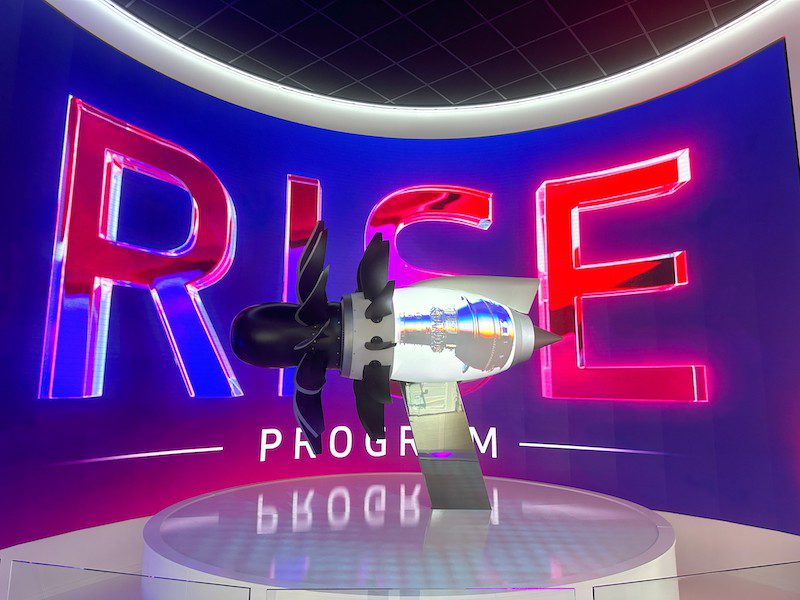 A model of an open fan engine, part of the RISE development program, seen this summer at the Paris Air Show.
A model of an open fan engine, part of the RISE development program, seen this summer at the Paris Air Show.
As of mid-2023, CFM had completed more than 100 tests as part of the RISE program, and GE Aerospace and Safran Aircraft Engines together have more than 1,000 engineers globally supporting the development of RISE program technologies. CFM is on track for ground and flight tests in the middle of this decade, including plans with Airbus for an open fan flight technology demonstration in the mid-2020s.
“The RISE program was launched as the absolute manifestation of our deep dedication to push the boundaries of innovation and deliver the breakthrough technologies that will help achieve our most aggressive sustainability goals in support of the industry promise of net zero by 2050,” says Gaël Méheust, president and CEO of CFM International. “Our global team of engineers has been accomplishing amazing things.” Read more about CFM’s RISE program here.
Hybrid Electric Flight
“GE Aerospace envisions a more electric future of flight,” says Arjan Hegeman, general manager of advanced technology for GE Aerospace. NASA’s Electrified Powertrain Flight Demonstration (EPFD) project is a landmark effort to help prove the feasibility of hybrid electric flight for commercial aviation. Working with NASA and Boeing, GE Aerospace is developing an integrated, megawatt-class hybrid electric propulsion system for ground and flight tests in the middle of this decade. Hybrid electric propulsion technologies can help improve engine performance, which reduces fuel usage and carbon emissions. In July, GE Aerospace debuted a new livery design for the aircraft test bed to be used in that project, a modified Saab 340B aircraft powered by GE Aerospace CT7 engines.
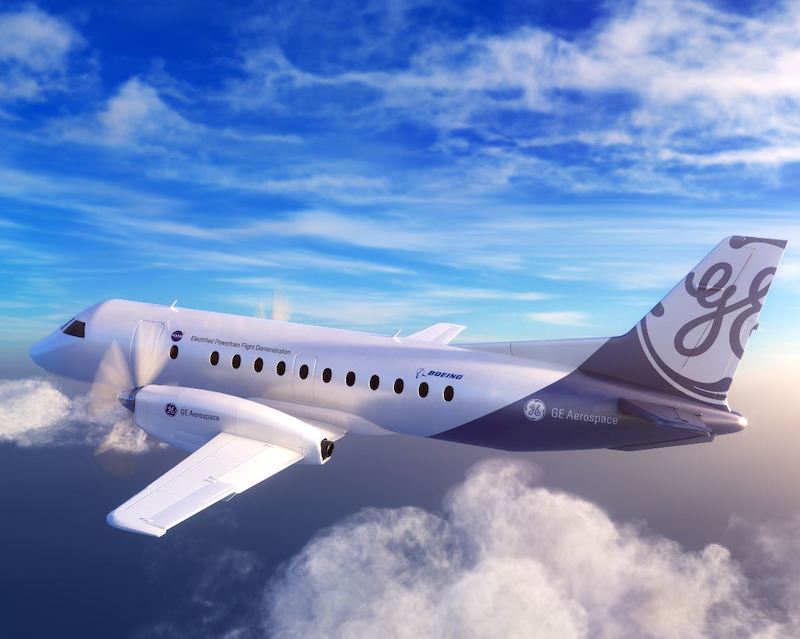 The Saab aircraft used for testing hybrid electric technology.
The Saab aircraft used for testing hybrid electric technology.
“Whether we’re going to be burning Jet A, SAF, hydrogen, or if we’re going to have batteries or fuel cells,” says Joseph Connolly, aerospace engineer at NASA’s Glenn Research Center, “the electrification of the subsystems and other components within the propulsion system on these aircraft is going to be more electric in the future.”
Read more about the EPFD project.
Sustainable Aviation Fuel
“Every piece of analysis shows that SAF is the most impactful way to cut aviation’s carbon emissions before 2050,” said Air Transport Action Group Executive Director Haldane Dodd this fall. At GE Aerospace, “SAF is not just an R&D project we conduct on the side,” said Gurhan Andac, the company’s engineering technical leader for aviation fuels and additives, in October. “It’s in the field. We have over half a million flights in the aviation industry. Granted, these are at very low volumes, but it’s out there and we’re flying.”
All GE Aerospace, CFM International, and Engine Alliance engines can operate on approved SAF blends today. SAF has the same chemical composition as the jet fuel most commonly used today, but instead of being made from fossil-based sources, SAF is made from more renewable sources that include plant-based material, fats, oils and greases, alcohols, waste streams, captured CO2, and other alternative feedstocks. The use of alternative feedstocks and processes reduces life-cycle CO2 emissions during production, processing, and distribution.
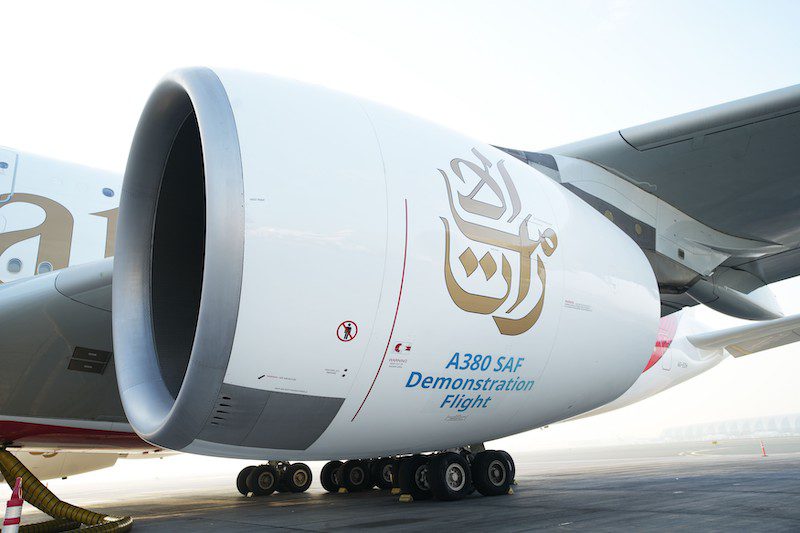 The Airbus A380 flown by Emirates this fall with 100% SAF in one of its engines. Credit: Emirates
The Airbus A380 flown by Emirates this fall with 100% SAF in one of its engines. Credit: Emirates
To bring SAF closer to everyday reality, GE Aerospace works with airline partners to test engine performance with the fuel. This year saw two SAF firsts on flights operated by the Dubai-based airline Emirates. In January, Emirates became the first to fly with SAF in the Middle East–Africa region, when a one-hour test flight on a Boeing 777-300ER used 100% SAF* to power one of its two GE90 jet engines. And last month, on another flight in the UAE, the world’s largest airliner, Airbus’s A380, used 100% SAF in one of its four GP7200 engines, manufactured by Engine Alliance, a 50-50 joint company between GE Aerospace and Pratt & Whitney.
“These test activities allow us to do analysis of engine performance,” says Andac. “We collect quite a bit of data in these flights. We compare that performance with historical data for that engine using a conventional fuel — or, in demos where only one engine was fueled by SAF, we compare it with the plane’s other, conventional-fuel-powered engine — and that data is fed into a research report that’s developed under ASTM International. From an overall engine performance perspective in a flight condition, this report has substantial value.”
Contrail Mitigation and More
Certain types of SAF also produce less soot than conventional jet fuel and therefore could help reduce contrails, which form in cold, humid air. This fall, to study this further, Boeing conducted flight tests on its ecoDemonstrator Explorer, a 737-10 destined for United Airlines whose CFM LEAP-1B engines operated with HEFA sustainable aviation fuel. A NASA DC-8 flew behind the ecoDemonstrator with a team of GE Aerospace engineers. “As we’re inventing the next generation of engines with the RISE program, we really want to understand the science around non-CO2 emissions,” said David Ostdiek, the CFM RISE systems team’s aerothermal leader.
 A NASA DC-8 chases Boeing’s ecoDemonstrator Explorer, a 737-10 destined for United Airlines, to take readings of emissions in a project to study SAF and contrail formation. Credit: Boeing
A NASA DC-8 chases Boeing’s ecoDemonstrator Explorer, a 737-10 destined for United Airlines, to take readings of emissions in a project to study SAF and contrail formation. Credit: Boeing
Also this year, it was announced that GE Aerospace’s CT7 engines that power the Sikorsky S-92 helicopter will use a blend of sustainable aviation fuel (SAF) and conventional jet fuel while undergoing maintenance, repair, and overhaul (MRO) at ITP Aero, a Spanish company that services the engines.
All in all, it’s been a big year for SAF. “We have to just continue the momentum,” says Joanne Morello, sustainable aviation fuels analyst at GE Aerospace’s Research Center. “The customers and the airlines need to continue to send very strong demand signals. We also need to start educating the flying public about SAF to help make aviation more sustainable and let them know we’re working on it and we have a path to get there.” To find out more about the state of SAF, see this Q&A with Morello and Andac earlier this year.
*100% SAF is not yet qualified by ASTM International, an organization that develops technical standards.
